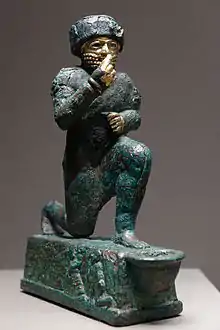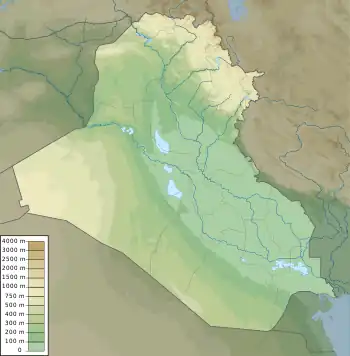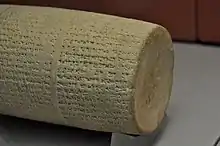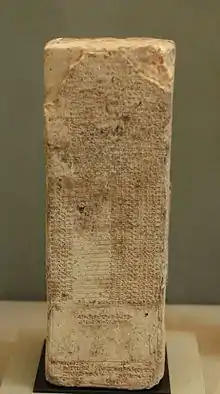Larsa
Larsa (Sumerian logogram: 𒌓𒀕𒆠 UD.UNUGKI,[1] read Larsamki[2]), also referred to as Larancha/Laranchon (Gk. Λαραγχων) by Berossos and connected with the biblical Ellasar, was an important city-state of ancient Sumer, the center of the cult of the sun god Utu. It lies some 25 km (16 mi) southeast of Uruk in Iraq's Dhi Qar Governorate, near the east bank of the Shatt-en-Nil canal at the site of the modern settlement Tell as-Senkereh or Sankarah.
 The Worshipper of Larsa, a votive statuette dedicated to the god Amurru for Hammurabi's life, early 2nd millennium BC, Louvre | |
 Shown within Near East  Larsa (Iraq) | |
| Location | Ishan al-Bahriyat, Al-Qādisiyyah Governorate, Iraq |
|---|---|
| Region | Mesopotamia |
| Coordinates | 31°17′9″N 45°51′13″E |
| Type | Settlement |

History
The historical "Larsa" was already in existence as early as the reign of Eannatum of Lagash (reigned circa 2500–2400 BCE), who annexed it to his empire.
The city became a political force during the Isin-Larsa period. After the Third Dynasty of Ur collapsed c. 2000 BC, Ishbi-Erra, an official of the last king of the Third Dynasty of Ur, Ibbi-Sin, relocated to Isin and set up a government which purported to be the successor to the Third Dynasty of Ur. From there, Ishbi-Erra recaptured Ur as well as the cities of Uruk and Lagash, which Larsa was subject to. Subsequent rulers of Isin appointed governors to rule over Larsa; one such governor was an Amorite named Gungunum. He eventually broke with Isin and established an independent dynasty in Larsa. To legitimize his rule and deliver a blow to Isin, Gungunum captured the city of Ur. As the region of Larsa was the main center of trade via the Persian Gulf, Isin lost an enormously profitable trade route, as well as a city with much cultic significance.
Gungunum's two successors, Abisare (c. 1841–1830 BC) and Sumuel (c. 1830–1801 BC), both took steps to cut Isin completely off from access to canals. Isin quickly lost political and economic influence.
Larsa grew powerful, but never accumulated a large territory. At its peak under king Rim-Sin I (c. 1758–1699 BC), Larsa controlled only about 10–15 other city-states — nowhere near the territory controlled by other dynasties in Mesopotamian history. Nevertheless, huge building projects and agricultural undertakings can be detected archaeologically. After the defeat of Rim-Sin I by Hammurabi of Babylon, Larsa became a minor site, though it has been suggested that it was the home of the First Sealand Dynasty of Babylon.[3] Larsa was known to be active during the Neo-Babylonian period based on building bricks as well as a number of cuneiform texts from the Larsa temple of Samash which were found in Uruk.[4]
Larsa is thought to be the source of a number of tablets involving Babylonian mathematics, including the Plimpton 322 tablet that contains patterns of Pythagorean triples.[5]
Kings of Larsa
| Ruler | Reigned (short chronology) | Reigned (L. Delaporte) | Comments | |
|---|---|---|---|---|
| Naplanum | c. 1961–1940 BC | Contemporary of Ibbi-Suen of the Third Dynasty of Ur | ||
| Emisum | c. 1940–1912 BC | |||
| Samium | c. 1912–1877 BC | |||
| Zabaia/Zabaya[6] | c. 1877–1868 BC | Son of Samium, first royal inscription | ||
| Gungunum | c. 1868–1841 BC | Gained independence from Lipit-Eshtar of Isin | ||
| Abisare | c. 1841–1830 BC | |||
| Sumuel | c. 1830–1801 BC | |||
| Nur-Adad | c. 1801–1785 BC | 2197 – 2182 BC | Contemporary of Sumu-la-El of Babylon | |
| Sin-Iddinam | c. 1785–1778 BC | 2181 – 2176 BC | Son of Nur-Adad | |
| Sin-Eribam | c. 1778–1776 BC | 2176 – 2174 BC | ||
| Sin-Iqisham | c. 1776–1771 BC | 2173 – 2169 BC | Contemporary of Zambiya of Isin, son of Sin-Eribam | |
| Silli-Adad | c. 1771–1770 BC | 2168 BC | ||
| Warad-Sin | c. 1770–1758 BC | 2167 – | Possible co-regency with Kudur-Mabuk, his father from Elam conqueror Larsa | |
| Rim-Sin I | c. 1758–1699 BC | Contemporary of Irdanene of Uruk. Defeated by Hammurabi of Babylon, brother of Warad-Sin. | ||
| Hammurabi of Babylon | c. 1699–1686 BC | Official Babylonian rule son Sin Muballit (2143 – 2124 BC). 2131 BC Sin Muballit gave battle against of Ur and Larsa | ||
| Samsu-iluna of Babylon | c. 1686–1678 BC | 2072 – BC | Official Babylonian rule | |
| Rim-Sin II | c. 1678–1674 BC | Killed in revolt against Babylon |
Archaeology

The remains of Larsa cover an oval about 4.5 mi (7.2 km) in circumference. The highest point is around 70 ft (21 m) in height.

The site of Tell es-Senkereh was first excavated, under the rudimentary archaeological standards of his day, by William Loftus in 1850 for less than a month.[7] Loftus recovered building bricks of Nebuchadnezzar II of the Neo-Babylonian Empire which enabled the site's identification as the ancient city of Larsa. Much of the effort by Loftus was on the temple of Shamash, rebuilt by Nebuchadnezzar II. Inscriptions of Burna-Buriash II of the Kassite dynasty of Babylon and Hammurabi of the First Babylonian dynasty were also found. Larsa was also briefly worked by Walter Andrae in 1903. The site was inspected by Edgar James Banks in 1905. He found that widespread looting by the local population was occurring there.[8]
The first modern, scientific, excavation of Senkereh occurred in 1933, with the work of André Parrot.[9][10] Parrot worked at the location again in 1967.[11] In 1969 and 1970, Larsa was excavated by Jean-Claude Margueron.[12][13] Between 1976 and 1991, an expedition of the Delegation Archaeologic Francaise en Irak led by J-L. Huot excavated at Tell es-Senereh for 13 seasons.[14][15][16][17][18] Numerous inscriptions and cuneiform tablets were found representing the reigns of numerous rulers, from Ur-Nammu to Hammurabi all the way up to Nebuchadnezzar II.[19][20]
See also
Notes
- ETCSL. The Lament for Nibru. Accessed 19 Dec 2010.
- ETCSL. The Temple Hymns. Accessed 19 Dec 2010.
- W. G. Lambert, "The Home of the First Sealand Dynasty", Journal of Cuneiform Studies, 26 (1974), pp. 208–210
- Beaulieu, Paul-Alain. “Neo-Babylonian Larsa: A Preliminary Study.” Orientalia, vol. 60, no. 2, 1991, pp. 58–81
- Robson, Eleanor (2002). "Words and pictures: new light on Plimpton 322" (PDF). American Mathematical Monthly. Mathematical Association of America. pp. 105–120. doi:10.2307/2695324..
- Weisberg, David B. “Zabaya, an Early King of the Larsa Dynasty.” Journal of Cuneiform Studies, vol. 41, no. 2, 1989, pp. 194–98
- William Loftus, Travels and researches in Chaldæa and Susiana; with an account of excavations at Warka, the Erech of Nimrod, and Shúsh, Shushan the Palace of Esther, in 1849–52, J. Nisbet and Co., 1857
- Edgar James Banks, "Senkereh, the Ruins of Ancient Larsa", The Biblical World, 25 (1905), no. 5, pp. 389–392
- Andre Parrot, Villes enfouies. Trois campagnes de fouilles en Mésopotamie, 1935
- A. Parrot, "Les fouilles de Tello et de. Senkereh-Larsa, campagne 1932–1933", Revue d'Assyriologie, 30 (1933), pp. 169–182, 1933
- André Parrot, "Les fouilles de Larsa", Syria, 45 (1968), pp. 205–239
- Jean-Claude Margueron, "Larsa, rapport preliminaire sur la quatrieme campagne", Syria, 47 (1970), pp. 271–287
- Jean-Claude Margueron, "Larsa, rapport preliminaire sur la cinquieme campagne", Syria, 48 (1971), pp. 271–287
- J. L. Huot et al., "Larsa, Preliminary Report on the Sixth Campaign", Sumer, 34 (1978), pp. 140–164
- J-L. Huot, "Larsa, rapport preliminaire sur la septieme campagne Larsa et la premiere campagne Tell el 'Oueili (1976)", Syria, 55 (1978), pp. 183–223
- J-L. Huot, Larsa et 'Oueili, travaux de 1978–1981. Vol. 26, Memoire, Editions Recherche sur les civilisations, 1983, ISBN 2-86538-066-1
- J.-L. Huot, Larsa (10e campagne, 1983) et Oueili: Rapport preliminaire, Editions Recherche sur les civilisations, 1987, ISBN 2-86538-174-9
- J-L. Huot, Larsa, Travaux de 1985, Editions Recherche sur les civilisations, 1989, ISBN 2-86538-198-6
- D. Arnaud, French Archaeological Mission in Iraq. "A Catalogue of the Cuneiform Tablets and Inscribed Objects Found during the 6th Season in Tell Senkereh/Larsa", Sumer, 34 (1978), pp. 165–176
- Huot, J.-L., 2014. L’E. babbar de Larsa aux IIe et Ier millénaires (fouilles de 1974 à 1985). BAH 205, Beyrouth
- Lionel Darras, Régis Vallet. La découverte des remparts de Larsa (Iraq) par la géophysique. XXIIIe colloque du GMPCA : Archéométrie 2022, May 2022, pp. 51–54, Chambéry, France
- Vallet, R. et al., sous presse. Preliminary Report on the XIVth and XVth Campaigns at Larsa. Sumer LXVI, 2020
References
- Judith K. Bjorkman, "The Larsa Goldsmith's Hoards-New Interpretations", Journal of Near Eastern Studies, vol. 52, no. 1, pp. 1–23, 1993
- T. Breckwoldt, "Management of grain storage in Old Babylonian Larsa", Archiv für Orientforschung, no. 42-43, pp. 64–88, 1995–1996
- Feuerherm, Karljürgen G. “Architectural Features of Larsa’s Urban Dwelling B 27.” Journal of Near Eastern Studies, vol. 66, no. 3, 2007, pp. 193–204
- Madeleine Fitzgerald, The Rulers of Larsa, Yale University Dissertation, 2002
- Ettalene M. Grice, Clarence E. Keiser, Morris Jastrow, Chronology of the Larsa Dynasty, AMS Press, 1979 ISBN 0-404-60274-6
- W.F. Leemans, Legal and economic records from the Kingdom of Larsa, Brill, 1954 ISBN 90-6258-120-X
- Lutz, Henry Frederick. Early Babylonian Letters from Larsa. Vol. 2. Yale University Press, 1917.
- Marcel Segrist, Larsa Year Names, Andrews University Press, 1990 ISBN 0-943872-54-5
- Tyborowski, Witold. “Šēp-Sîn, a Private Businessman of the Old Babylonian Larsa.” Die Welt Des Orients, vol. 33, 2003, pp. 68–88.

